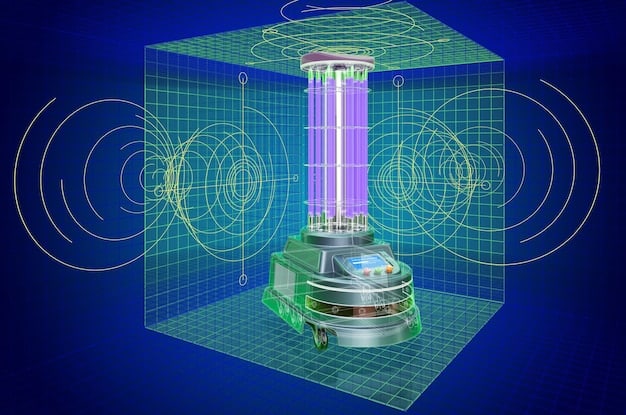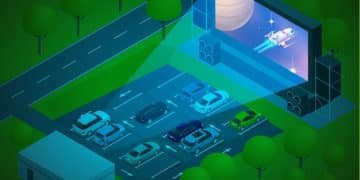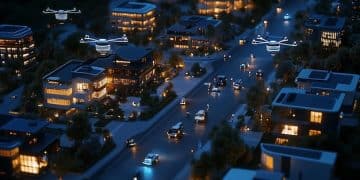LiDAR’s Role: Enhancing Autonomous Vehicle Accuracy in the US

LiDAR technology plays a crucial role in enhancing the navigation accuracy of autonomous vehicles in the US by providing high-resolution 3D mapping and real-time object detection capabilities, enabling safer and more reliable self-driving systems.
The advent of autonomous vehicles promises a revolution in transportation, but their safe and reliable operation hinges on accurate navigation. In the diverse and often challenging environments of the US, achieving pinpoint navigation accuracy is paramount. This is where the **role of LiDAR in enhancing autonomous vehicle navigation accuracy in US conditions** becomes indispensable.
Understanding LiDAR Technology and Its Function in Autonomous Vehicles
LiDAR (Light Detection and Ranging) is a remote sensing technology that uses laser light to create a 3D representation of the environment. For autonomous vehicles, LiDAR serves as a crucial sensor, providing detailed information about the surroundings that other sensors like cameras and radar may miss. Its ability to generate accurate 3D maps in real-time makes it essential for navigation, especially in complex urban settings.
How LiDAR Works
LiDAR systems work by emitting laser pulses and measuring the time it takes for the light to return after hitting an object. This “time of flight” is used to calculate the distance to the object. By scanning the environment with numerous laser pulses, LiDAR creates a dense point cloud that represents the shape and location of objects in detail.
Unlike cameras that rely on ambient light or radar that can be affected by weather conditions, LiDAR provides consistent and accurate data regardless of lighting conditions or weather, making it extremely reliable for autonomous navigation.

LiDAR vs. Other Sensor Technologies
Autonomous vehicles typically employ a combination of sensors, including cameras, radar, and LiDAR. While each has its strengths, LiDAR stands out for its ability to provide high-resolution 3D data, which is especially useful in situations where precise object detection and distance measurement are critical. Here’s a brief comparison:
- Cameras: Provide rich visual information but can struggle in low-light conditions and are often less accurate for distance measurement.
- Radar: Effective for detecting objects at long distances, but provides less detailed information about their shape and size.
- LiDAR: Offers high-resolution 3D data with accurate distance measurements, making it ideal for precise navigation and object detection.
The use of LiDAR in autonomous vehicles provides a critical layer of safety and enhances navigation accuracy, particularly in challenging US driving environments.
The Importance of High Accuracy Navigation in US Conditions
The United States presents a unique set of challenges for autonomous vehicle navigation, including diverse weather conditions, varying road infrastructure, and complex urban environments. High-accuracy navigation is not just a convenience; it’s a necessity for ensuring the safety and reliability of self-driving systems.
Weather Challenges
From heavy rain and snow in the northern states to intense sunshine and fog in coastal areas, the US experiences a wide range of weather conditions that can affect sensor performance. High-accuracy navigation systems must be able to function reliably in adverse weather to ensure the safe operation of autonomous vehicles.
Urban and Rural Environments
The US also presents a mix of urban and rural driving environments, each with its own set of challenges. Urban areas are characterized by dense traffic, pedestrians, and complex road layouts, while rural areas may have poor road maintenance and limited infrastructure. High-accuracy navigation systems must be adaptable to these varying conditions.
Regulatory Requirements
Different states in the US have varying regulations regarding autonomous vehicles. Meeting these regulatory requirements necessitates the use of highly accurate navigation systems that can provide verifiable data about the vehicle’s location and performance.
In essence, the diverse conditions and regulatory landscape of the US underscore the critical importance of high-accuracy navigation for autonomous vehicles, making LiDAR a valuable, and often essential, component.
Benefits of LiDAR in Enhancing Navigation Accuracy
LiDAR technology offers several key benefits that contribute to enhancing the navigation accuracy of autonomous vehicles. Its ability to provide detailed 3D maps, real-time object detection, and reliable performance in various conditions makes it an invaluable tool for self-driving systems.
Detailed 3D Mapping
LiDAR creates high-resolution 3D maps of the environment, allowing autonomous vehicles to understand the precise location and shape of objects. This is especially useful in urban areas where buildings, pedestrians, and other vehicles can create complex and dynamic surroundings.
Real-Time Object Detection
LiDAR’s ability to detect objects in real-time enables autonomous vehicles to react quickly to changes in their environment. Whether it’s a pedestrian crossing the street or a car changing lanes, LiDAR provides the data needed for the vehicle to make informed decisions.
Improved Safety
By enhancing navigation accuracy, LiDAR contributes to improved safety for autonomous vehicles. Accurate navigation reduces the risk of accidents and helps the vehicle navigate safely in challenging driving conditions.
The superior levels of detail and accuracy afforded by LiDAR systems directly translate to heightened safety and confidence for autonomous vehicle operations across the US.
LiDAR Integration with Other Sensor Technologies
While LiDAR offers numerous advantages, it is typically integrated with other sensor technologies to create a comprehensive perception system for autonomous vehicles. This sensor fusion approach combines the strengths of each technology to provide a more robust and reliable understanding of the environment.
Sensor Fusion Techniques
Sensor fusion involves combining data from multiple sensors to create a more accurate and complete representation of the environment. For example, LiDAR data can be combined with camera images to provide both 3D spatial information and rich visual details.
Complementary Strengths
Integrating LiDAR with radar and cameras leverages the complementary strengths of each technology. Radar can detect objects at long distances, cameras provide visual details, and LiDAR offers high-resolution 3D data. Together, these sensors create a robust and reliable perception system.
By effectively fusing data from various sensors, autonomous vehicles can achieve a higher level of situational awareness and make more informed decisions, ultimately improving safety and navigation accuracy.
Challenges and Limitations of LiDAR Technology
Despite its many benefits, LiDAR technology also has its challenges and limitations. Understanding these challenges is crucial for optimizing LiDAR systems and developing strategies to mitigate their impact on autonomous vehicle navigation. Some of the key considerations are.

Cost
LiDAR systems can be expensive, which can be a barrier to widespread adoption. However, costs have been decreasing in recent years, and advancements in technology are expected to further drive down prices.
Environmental Sensitivity
While LiDAR performs well in various lighting conditions, it can be affected by certain environmental factors, such as heavy rain, snow, and fog. These conditions can reduce the range and accuracy of LiDAR, requiring alternative strategies for navigation.
Data Processing
LiDAR generates large amounts of data, which requires significant processing power and sophisticated algorithms to interpret. Developing efficient and accurate data processing methods is essential for real-time navigation.
Addressing these challenges and limitations is crucial for realizing the full potential of LiDAR technology in autonomous vehicles.
Future Trends and Developments in LiDAR Technology
The field of LiDAR technology is constantly evolving, with new trends and developments emerging that promise to further enhance the navigation accuracy and capabilities of autonomous vehicles. Innovation continues with advancements in both hardware and software. Consider some of the following trends in this field.
Solid-State LiDAR
Solid-state LiDAR systems offer several advantages over traditional mechanical LiDAR, including lower cost, smaller size, and greater durability. These systems use electronic components to steer the laser beam, rather than mechanical parts, making them more reliable and less prone to failure.
4D LiDAR
4D LiDAR adds velocity as a fourth dimension to the traditional 3D point cloud, providing even more detailed information about the environment. This can improve object detection and tracking, especially in dynamic environments.
Software Advancements
Advancements in software algorithms and data processing techniques are also enhancing the performance of LiDAR systems. Machine learning and artificial intelligence are being used to improve object recognition, reduce noise, and optimize navigation strategies.
These future trends and developments promise to make LiDAR technology even more effective and widespread in the field of autonomous vehicles, supporting safer and more reliable navigation.
| Key Point | Brief Description |
|---|---|
| 💡 LiDAR Functionality | Uses laser light to create 3D maps of the environment for autonomous vehicles. |
| 🛣️ US Navigation Challenges | Diverse weather, varying infrastructure, and complex urban settings require high accuracy. |
| 🤖 Sensor Integration | LiDAR is integrated with cameras and radar for a comprehensive perception system. |
| 🚀 Future Trends | Solid-state and 4D LiDAR, along with software advancements, aim to further improve accuracy. |
Frequently Asked Questions
▼
LiDAR (Light Detection and Ranging) is a remote sensing technology that uses laser light to create a 3D representation of the environment, crucial for autonomous vehicle navigation.
▼
LiDAR enhances navigation by providing high-resolution 3D maps and real-time object detection, allowing vehicles to navigate accurately and safely.
▼
Challenges include diverse weather conditions, varying infrastructure, high costs, and the need for sophisticated data processing.
▼
LiDAR is integrated with cameras and radar through sensor fusion techniques to create a comprehensive and reliable perception system.
▼
Future trends include solid-state LiDAR, 4D LiDAR, and advancements in software algorithms, all aimed at improving accuracy and reliability.
Conclusion
In conclusion, the **role of LiDAR in enhancing autonomous vehicle navigation accuracy in US conditions** is undeniable. Its ability to provide detailed 3D mapping, real-time object detection, and robust performance in varying conditions makes it an indispensable technology for self-driving systems. Despite the challenges, ongoing advancements in LiDAR technology promise even greater accuracy and reliability in the future, paving the way for safer and more efficient autonomous transportation in the US.





